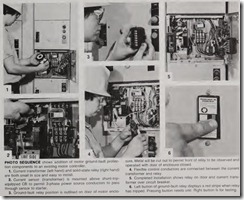How ground fault systems protect motor loads
By GREGORY C. ECKART
MOTORS AND MOTOR CIRCUITS
normally are well designed to provide adequate protection from short-circuit conditions and overloads. The damage or potential damage resulting from such faults are well known, and devices such as circuit breakers, fuses, and overload relays can be applied to obtain the needed protection. However, a third type of fault condition, a ground fault, can be just as destructive as an overload or short circuit and far more insidious.
Modern power distribution systems are typically rated 480/277 V and as such are susceptible to ground faults. These systems and motors connected to them can often be destroyed by ground faults if proper protection is not pro vided.
Today, many plants have ground fault protection down to the feeders and large motors, but this may not be enough. Low-level arcing ground faults in unprotected downstream motors cause extensive motor replacement and repair costs. These faults cause severe deterioration of motor windings and laminations. Furthermore, low-level ground faults can escalate quickly and shut down motor control centers, which in certain cases may result in the entire manufacturing plant being shut down.
To provide the needed protection, new solid-state ground-fault protection systems have been designed and made available. As shown in the accompany ing diagram and photos, a typical sys tem consists of a current sensor (usually a donut-type current transformer) and a multifunction solid-state relay. Usually, indication is provided on the relay; but remote monitoring is also available.
The ground-fault systems are used toprotect single-phase and polyphase ac motors rated from 20 to 500 hp. They can also be used on larger voltage- and hp-rated motors but will probably require different current transformers than normally supplied with the ground-fault relays. In most cases, this will depend on the sizes and types of cables installed.
The devices are installed where the continuous use of a motor is critical to a manufacturing process or where find ing a replacement for a burned-out motor is difficult. There is less need for ground fault protection on fractional hp or integral-hp motors below 20 hp. These motors are usually kept in stock or are easy to obtain.
Ground-fault protective devices are small, compact, and inexpensive; and they can be installed in existing motor control centers and·combinriion start ers. The ground-fault relays may be wired to operate a “circuit-breaker shunt trip or to drop out a con tactor. Normall y closed contacts are rated 15 A continuous, 90 A mak e and 15 A break, and 120 V ac. Normally open contacts are 3 A continuous, 15 A inrush. Th ey are suitable for use on systems capable of deliveri n g up to 100,000 A rrns phase-to-ph ase or phase-to-ground current.
A current transformer, which de tects ground faults, serves as a signal ing device and is smaller and more compact than conventional current sensors. Current sensors have a 6-step range to allow selecting the specific pickup setting that is correct for a particular application, from 50 rnA to 30A.
The relay, although very sensitive, has an inverse time-delay characteris tic with an instantaneous unit for intermediate and high-l evel ground faults and has a very high resistance to nuisance tripping . Ground-fault-trip ampere adjustment ranges available are: 0.05 to 0.3; 0.1 to 0.6; 0.5 to 3.0; 1.0 to 6.0; 2.0 to 12.0, and 5.0 to 30.0.
When selecting a trip setting, con tractors, consultants and plant electri cal people often choose “the lowest pos sible” setting. Others believe the trip setting is selected based on what the user feels is most comfortable. In any event, the proper setting is usually dependent upon three parameters:
(1) the amount of damage the operator or owner is willing to permit,
(2) whether there is more than one load on a circuit, and (3) whether a nonmotor load on the circuit, such as a heater, requires a higher than nor mally permissible setting.
To annunciate the occurrence of a fault, the system has an integral ground-fault target indicator. The pro tection system also has an integral test mechanism that enables the user to simulate a fault to make sure the systern is working.
In addition to protecting motors and the distribution system, the ground fault relay can be wired to provide personnel protection (GFCl) on the 120-V circuit. Plant workers can be provided with ground-fault circuit in terruptions at 5 rnA, the level estab lished by the NEC and Underwriters Laboratories for personnel protection .
In recommending circuit protection for motors against all three types of faults, the best approach would be a starter with overload relays, a magnet ic-only circuit breaker, and a separate ground-fault relay. The overload relays protect both the cable and the motor. The CB provides short-circuit protec tion for the starter with overload relays, cable, and the motor; and the ground-fault relay protects motors on the 480V circuit and provides control circuit ground-fault circuit interrup tion protection for personnel.

